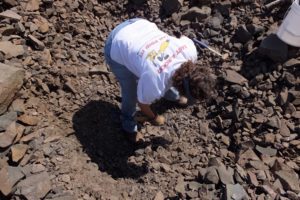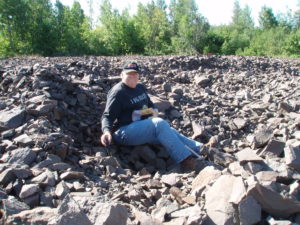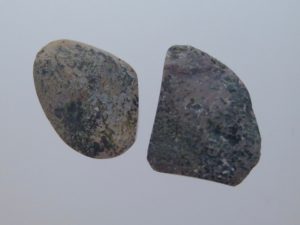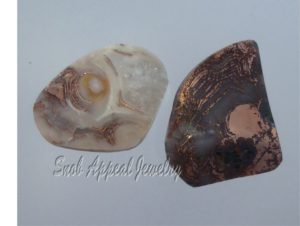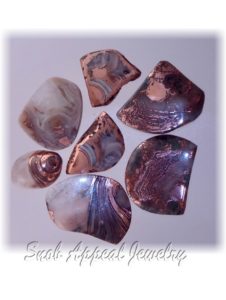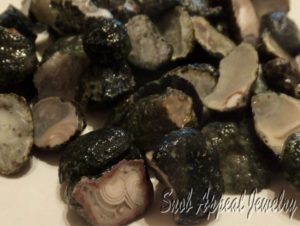After 20 years of searching the mine spoil piles in the Keweenaw, with great success, I have to admit one of my biggest blunders. I used to dig large holes in the what was left of the C&H pile, near Calumet, with my buddy Bill, looking for Datolites. At that time, if I came across a piece of copper while Datolite digging, I would keep it, but I would also find other Chlorite covered nodules, that we would call copper balls and just heave them out of the hole.
Today these Chlorite covered nodules are coveted by collectors around the world. You guessed it–Many of these nodules we threw away were Copper Banded (Infused) Agates. Nobody knew at that time that these things would end up being valuable gemstones. Later I learned that my friend, the late John Perona and his brother knew about these agates for many years. Today, we also know that these special agates are found nowhere else in the world except in the Kearsarge Lode. The Powebic Lode to the South where the Quincy, Mesnard, and Franklin Mines resided, have not produced Copper Agates. You do not see Copper Agates in the rocks of the Fissure and Stratiform Deposits to the North either; so the Kearsarge Lode of the Calumet Conglomerate is very unique indeed.
It’s been so many years that I forgot where my hole was, and the area has been tilled up a few times, so all those agates I threw out; who knows where they are. I actually looked for my old hole last time I was in the area. I clearly forgot where it was.
A diligent and alert Rockhound can still find Copper Agates in the Kearsarge Lode if they are willing to put in some work excavating and carefully observing the pieces of spoil rock that might contain nodules that read “hot” with a pinpoint metal detector. I enjoy sitting down and digging, especially in late August, after Black Fly season. It’s even better if it’s raining. These little balls of glory stand out a whole lot better in the rain. the usual scenario is you see a rock of rubble with nodules in it and try to extract them with tools.
How these agates formed is debatable, but the theory that makes the most sense is suggested by the Lynch brothers in their fine book Agates of Lake Superior. You’ll have to read the book to see what they say about Copper Infused Agates. I prefer that term over Copper Replacement Agates, but most of the time I just refer to them as “Copper Agates“.
My last trip involved some very successful Greenstone digging, but no Copper Agate hunting. I only had limited rock hunting time this trip, so I had to chose between Greenstones or Copper Agates.
Copper Agates are rarely really large, but some real sizable. Fully banded beauties, are sometimes found as large as a half dollar. I’m happy to find a dime sized one, but like Greenstones, a big hunker is very welcome, and always elicits a “WHOOP!”.
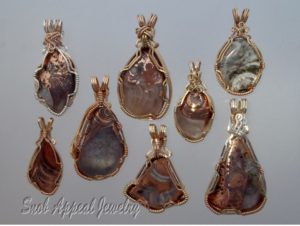
Here are most of those Cabochons from above turned into jewelry. All these are for sale at: www.snobappealjewelry.com
I do have miner friends in the area that usually have some Copper Agates for sale, so I always buy a few. I purchase these agates with the question; Can I make these better? If I believe that I can, I will take them home for a re-work before making jewelry. Most often Copper Agates are cut in half and sold as a pair, but often I take a pair and grind the rind off the outside where better banding may appear (or may not). Often, the odd shapes of these nodules do not allow working the outside rind, due to all the gaps and dips in the stones, so these I either work with what the slice has produced or just sell or trade these for specimens. Most Copper Agates are bought as specimens and not so much for jewelry.
The Kearsage Lode also produces small pastel, banded agates that have little of no copper in them, but are very fine; we refer to these as “mine agates”. When found these are also Chlorite covered, just as are the Copper Banded Agates. I take everything and sort them by removing the crust in my home shop.
I work Copper Agates using my soft wheels only with loads of water to keep them cool and, for proper lubrication, an additive is added to the water when cutting. Special grinding techniques are used also. I generally treat these Copper Infused Agates with a coating to make them tarnish resistant, rather than polishing them. The coating I use is one of my trade secrets.
I sell Copper Agate pendants on line, at art shows and within a mile of where I find them, at Copper World, in Calumet. The jewelry I make from these rare agates is spectacular, simply because the Copper Agates are spectacular. It seems as though Copper Banded Agates are becoming very popular as of late. I have a good selection now, and you should remember, the closer to Christmas, the more your choice narrows.
I hope you have sensed my frustration at having tossed out hundreds of Copper Agates. I’ve got to work on my memory, because if I get it back, I’ll be INFUSED with Copper Infused Agates.








